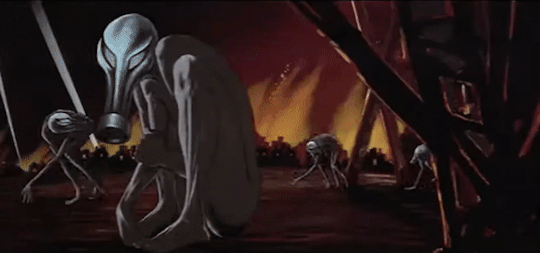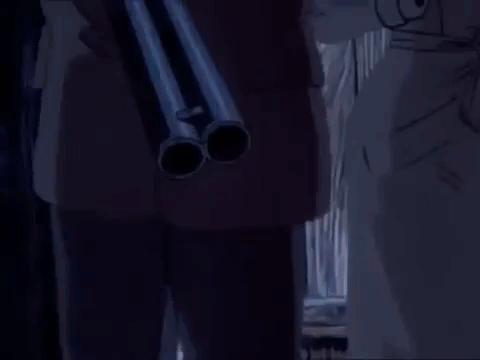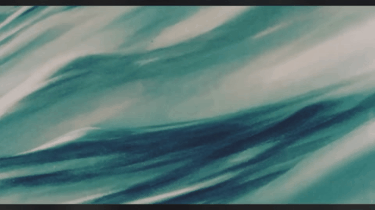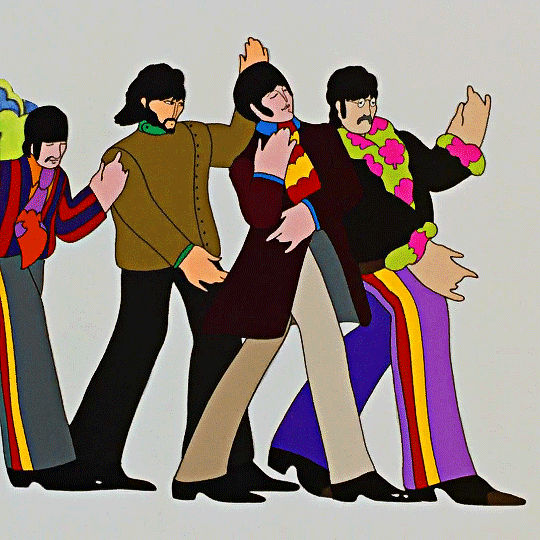originally posted at https://canmom.tumblr.com/post/672030...
Fuck damn, it’s been an entire year (minus one day) since Animation Night 34, on which we watched Akira on New Year’s Eve. We’ve had a few time slippages, but we’ve not missed a week yet!
Since I landed back on these shores not so long ago, I think it’s time we took another look at the animation of miserable old Blighty.

Traditional animation is pursued only rarely here, but when it has been, mostly in the brief flourishing of countercultural animation in the 70s and 80s, the results have been genuinely striking - and, notably, quite overtly political and boldly violent, deeply unsympathetic to their host state
We’ve encountered two of them before in the course of this series: Watership Down (1978, Animation Night 23) dir. Martin Rosen stands in a realist tradition of animation (unrelated, so far as I know, to the one that would later develop in Japan) to depict the struggles and spirituality of rabbits poised on the edge of death at the hands of all and sundry: foxes, cats, humans the elements, and indeed a colony of fascist rabbits. Meanwhile,When The Wind Blows (1986, Animation Night 26) dir. Raymond Briggs quietly watches an old couple die slowly of radiation poisoning after a nuclear war.
Friends, it’s not good here!

Tonight, I’m going to bring you Rosen’s second film, The Plague Dogs (1984), which landed four years after Watership Down to a much colder reception. Like it’s predecessor, it’s adapted from a novel by Richard Adams, focusing on a group of animals in a hostile world. This time around, the role of humans is much more direct: the dogs are escapees from an animal testing lab - a subject that’s common in animation from Bluth’s The Secret of NIMH (Animation Night 31) to Osamu Tezuka’s Bagi, the Monster of Mighty Nature but rarely treated with level of tragic seriousness.
This time around, the British animators collaborated with a team in San Francisco, among them a couple of experienced dog animators: Brad Bird of Iron Giant fame, who was at the early point working on troubled Disney films such as The Fox and the Hound (1981), and Retta Scott, whose drawings of vicious hunting dogs for Bambi once persuaded old Walt to draw an exception in his strict gender-segregationist policy in the 30s. Beyond that… I can find relatively little about its production. So let’s go on to talk about the film itself!

The story concerns two dogs who, heavily traumatised by their brutal experiences in the testing lab, go on the run across England pursued by a state which has marked them for death as potential disease carriers. Rowf, large and cynical, grudgingly follows the terrier Stitter who holds out hope that somewhere at the end there will be freedom.
Compared to Watership Down, the film offers very little comfort to soften the blow. There is no straightforward villain who could be defeated or happy release; its ending is at best ambiguous. Its characters have been praised for their emotional depth, e.g. here:
In Rosen’s film, anthropomorphic animals are not used to delight children or to shock adults, but instead are there to direct a viewer’s eye to humanity’s many sins against nature. The film does this with compassion, and miraculously, without an ounce of preachiness, allowing everything to first and foremost be in service of the characters and their journey. These dogs are not silent Old Yellers looking cute in the background, waiting for their big tear jerker death scene; Stitter and Rowf are given the dignity of having distinct personas that have a truly primal animal quality to them despite the fact that they were crafted by human storytelling.
Tragically, audiences of the time were not appreciative of such an uncompromising and painful animated film, and Rosen never got the chance to make another; soon all that remained of animation in this country would be Aardman (Animation Night 50) and relatively low-effort childrens’ shows, with stop motion largely giving way to CG.

If Rosen’s adaptations of Adams’s novels suggest a certain stance by depicting the bucolic British countryside shot through with violence and animal cruelty, Pink Floyd’s The Wall seems to be far more direct - though I’ll be able to discuss its themes in more depth once I’ve actually seen it >< The origins of the film, and its accompanying album, lie in the mid 70s, and the discomfort of songwriter Roger Waters with the machinery of fame. He channelled this into a very self-reflexive film, presenting the biography of a rock star facing existential questions and going through a breakdown in which he dreams of goose-stepping hammers as he is pushed to continue to perform.
A full history of Pink Floyd and their significance would be well outside my bailiwick, so let’s talk about animation. In this case, it’s all the work of Gerard Scarfe. Primarily a political cartoonist - working, I was surprised to notice, for mostly right-wing papers - Scarfe began working with Pink Floyd (I almost wanted to shorten that to Floyd there like it’s a personal name lmao) after they saw his BBC film A Long Drawn Out Trip.
Before long, they were collaborating on comics and animation to support their tour of America, with the centrepiece being the seven minute video for Welcome to the Machine featuring some impressive gore (with blood especially being a recurring motif in Scarfe’s work). Scarfe’s animations here are unusual in eschewing cel shading, going instead for an airbrushed look which I can only imagine must have been incredibly difficult to keep consistent even at the fairly low drawing count. So the plan for The Wall was that Scarfe would create even more animation, interspersed with live action sequences, for a full length film.
The most notable thing about the production of The Wall was that, outside of the Waters/Scarfe duo, everyone involved seems to have despised each other. Waters was originally set to star, but after some tests, he was replaced with Bob Geldof, who ranted to his manager about his disdain for the role unaware that his taxi driver was in fact Waters’s brother. But worst was the relationship with director Alan Parker:
Parker, Waters and Scarfe frequently clashed during production, and Parker described the filming as “one of the most miserable experiences of my creative life.”[15] Scarfe declared that he would drive to Pinewood Studios carrying a bottle of Jack Daniel’s, because “I had to have a slug before I went in the morning, because I knew what was coming up, and I knew I had to fortify myself in some way.”[16] Waters said that filming was “a very unnerving and unpleasant experience”.[17]
When the film landed, it met a mixed reception - but a lot of praise went to the Scarfe’s vivid, surreal depiction of fascist rallies and war in the dream sequences dreamed up at the height of the protagonist’s self-isolation. Such themes have recurred occasionally in animation, from Todd McFarlane’s music videos to Mahiro Maeda’s short The Second Renaissance on the Animatrix, but this seems to be one of the oldest. The use here was interpreted by at least one critic to refer to Thatcher’s war over the Falklands, but while Thatcher certainly deserves the comparison, I feel like that is too narrow: it’s the entire psychic structure of this country, right?

Our last instance of that brief window of traditional animation in these parts comes from, sigh, the Beatles. The film Yellow Submarine (1968) is notable in animation history terms for being an early instance of a film breaking out of the ‘only for kids’ orthodoxy, and especially for its early use of limited animation techniques (albeit postdating the Dover Boys) and experiments with unusual animation media. A package film that’s cheerfully light on plot, it comprises a series of vignettes illustrating different Beatles songs, not unlike old Walt’s Fantasia, with a distinctive art direction created by Czech-German illustrator Heinz Edelmann. Some use rotoscopy, some depict surreal morphing; it is cited widely when later animators wish to depict a psychedelic sequence.
Hopefully, even with the Beatles at the centre, it will be a little of a colourful, weird palate cleanser after grinding your face into the muck of humanity with the other two films!

What to say of these films? In terms of their era, they might be placed in the clumsy rise of more adult-oriented animation, such as Bakshi’s Fritz the Cat. They definitely all feel like they’re reaching for a possibility for expression that had not really been explored before; they’re also broadly rooted in a period of ‘counterculture’ in the 70s and 80s that has for the most part since been either recuperated or suppressed.
At the same time as all this, in Japan’s economic boom half a world away, for better and worse, animation managed to construct an adult subculture it could cater to with the otakus. This certainly came with its limits, and many of these films started to lose their more overt political content, but it did manage to incubate a very distinctive and diverse tree of animation traditions (see: ~70% of animation night posts) which, by virtue of the sheer amount of animated film being produced and a production system which allowed animators to develop an individual voice, would put out real gems almost every year, even through the subsequent downturns. Anime now ‘enjoys’ a period of intense overproduction; it remains to be seen how it will snap, but it has established enough of an overwhelming presence in the psychic plane that it is unlikely to disappear.
Meanwhile in continental Europe and Ireland, animation found a different place to rest with somewhat more arthouse films, supported by various governments’ arts council funding and the infrastructure of film festivals such as Annecy. These films run wild through the aesthetic space, tending to reinvent themselves over and over with each change of production techniques rather than standardise a pipeline as in America or Japan. Still, it seems to work!
Alas, the same did not happen here; while the BBC would occasionally throw its money behind an interesting short film, these creative, compelling feature films remain a handful of oddities that are unlikely to ever be revived.
Which is a shame! But that’s the UK. It wouldn’t be British without being kind of disappointing.
Animation Night 86 will be starting very shortly at the usual place of twitch.tv/canmom! Hope to see you there!
Comments